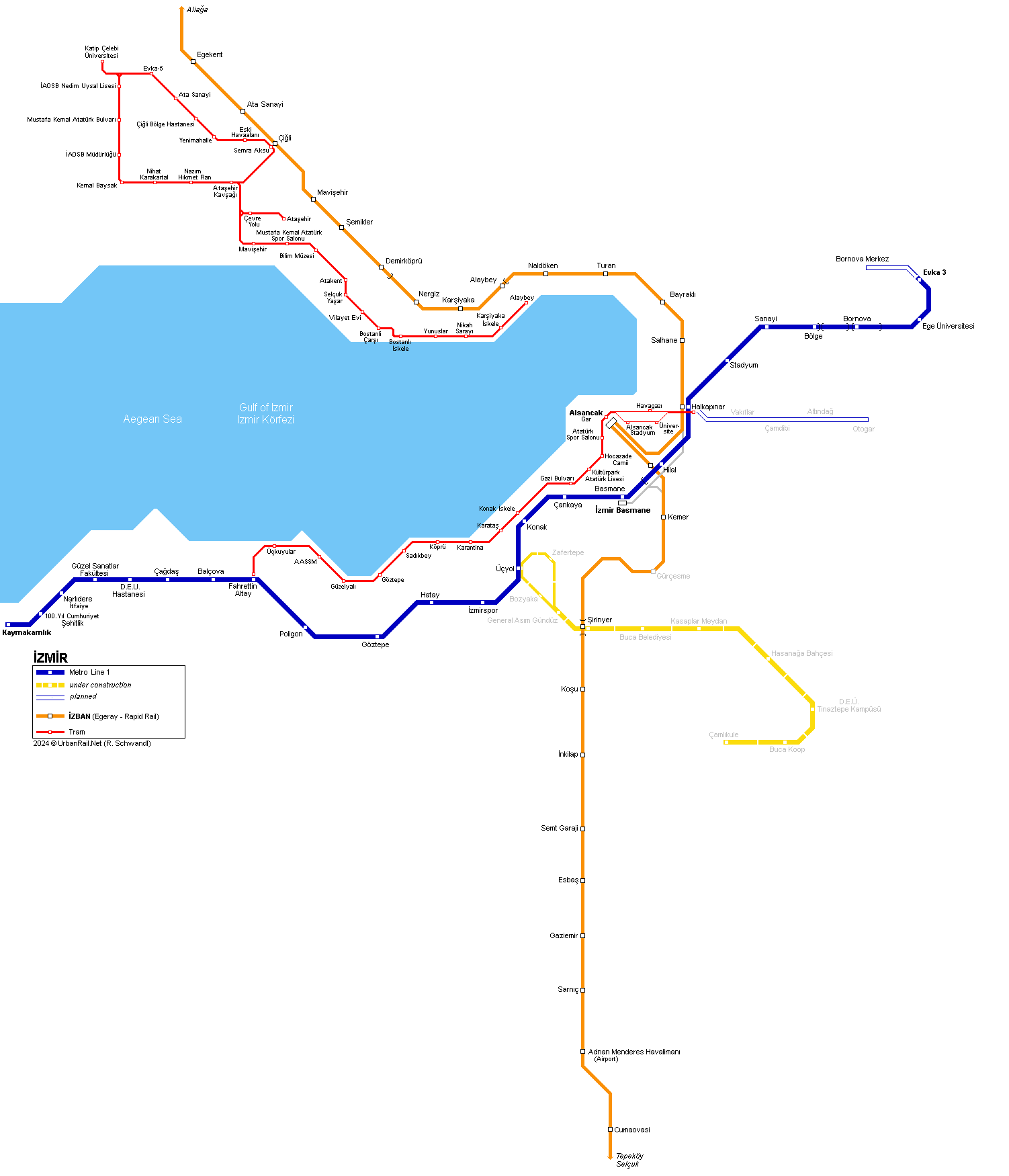
|
[ UrbanRail.Net ] [ Europe ] [ Americas ] [ Asia ] [ Africa ] [ Oceania ] [ News ] [ Books ] [ Links ] |
|
İZMİR
|
| Turkey |

|
METRO
|
||
|
Izmir's first metro line is 25 km long and has 24 stations (2024). It opened for trial service on 22 May 2000, regular passenger service started on 25 August 2000. The line runs mostly underground, but elevated for 2.3 km (Hilal - Halkapinar) and at grade or in a cutting for 4.8 km (Stadyum - Bornova). Platforms are 125 m long, although initially only 3-car-trains (750 V DC) were used. At Halkapinar and Hilal transfer is possible to the suburban railway Izban. The metro was originally built as a turnkey project by a consortium led by Adtranz and is operated by Izmir Metro A.S.
|
||
|
History
|
||
|
25
Aug 2000:
Üçyol - Bornova (10.8
km) |
||
| Photos | ||
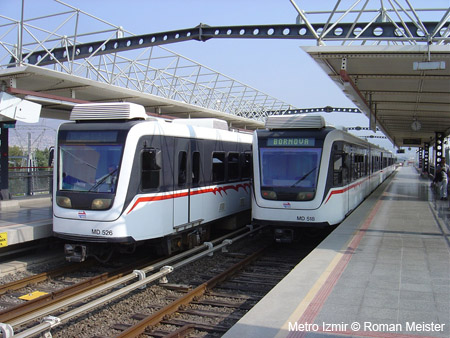
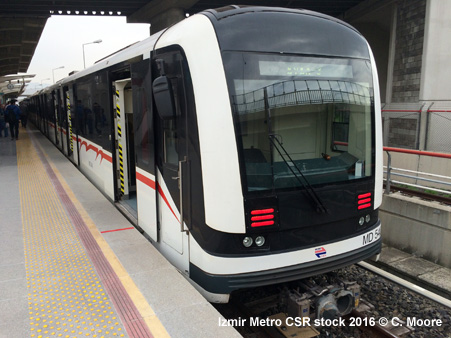
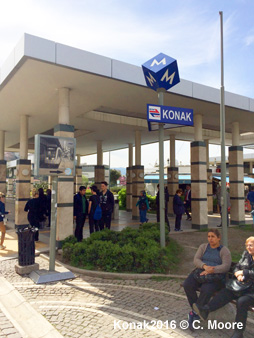
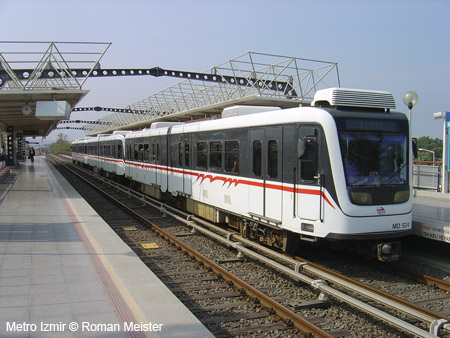
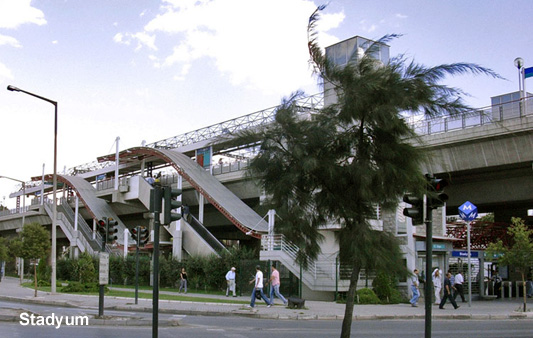
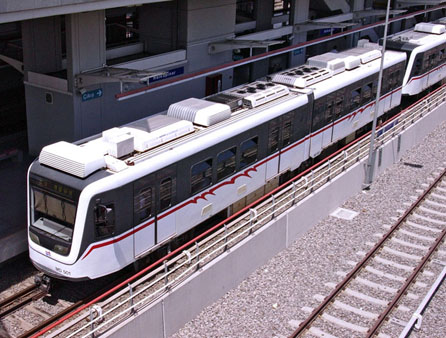
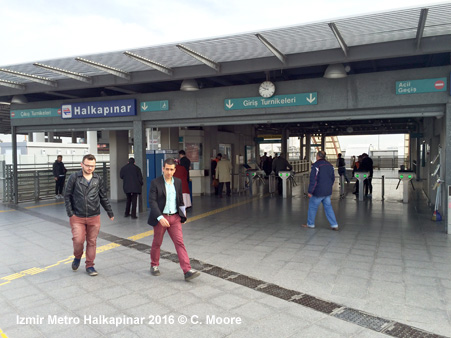
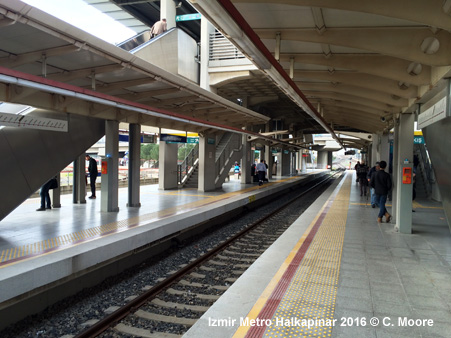
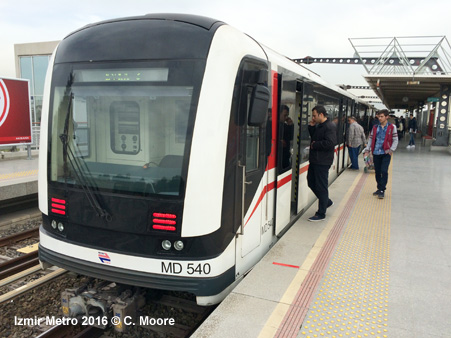
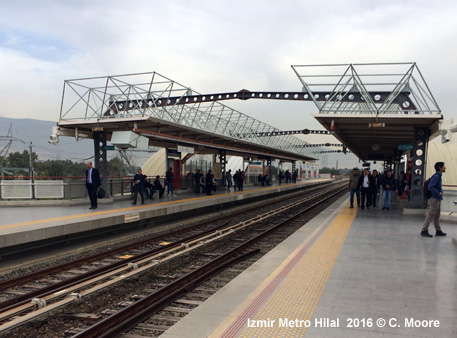
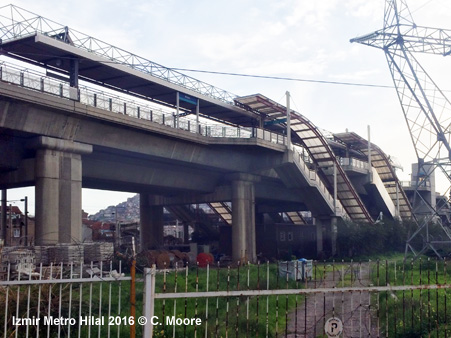
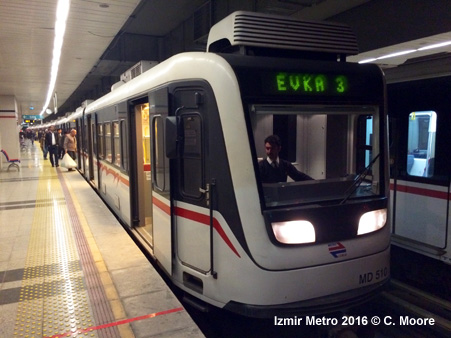
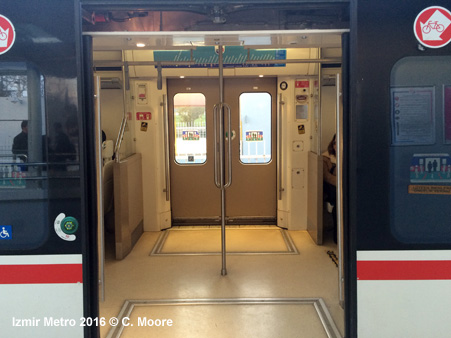
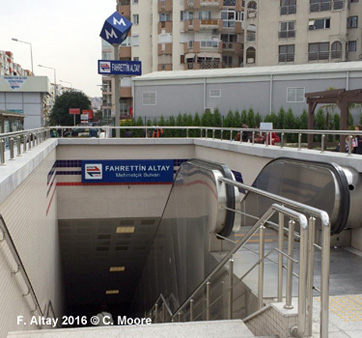
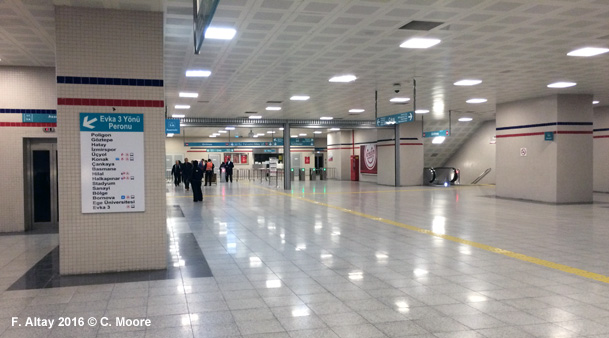
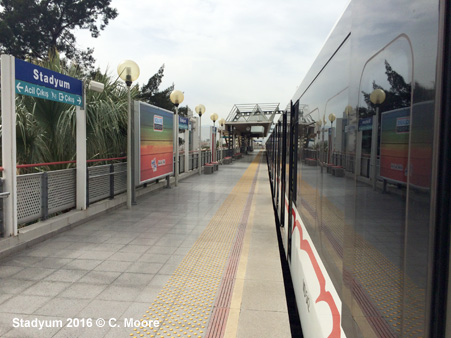
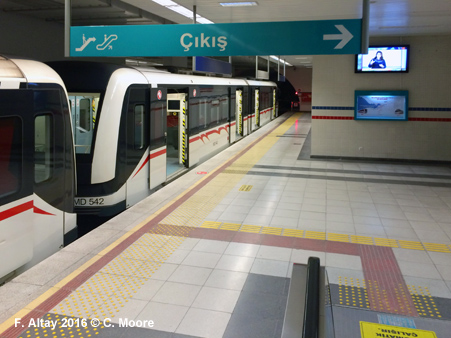
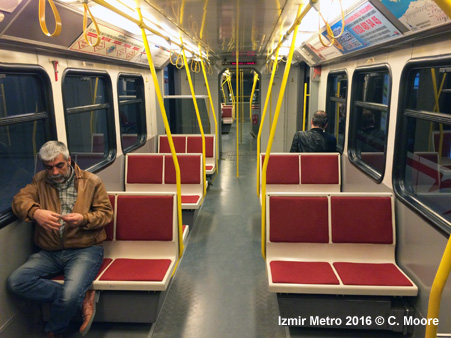

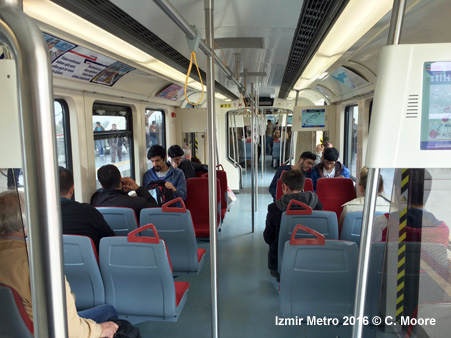
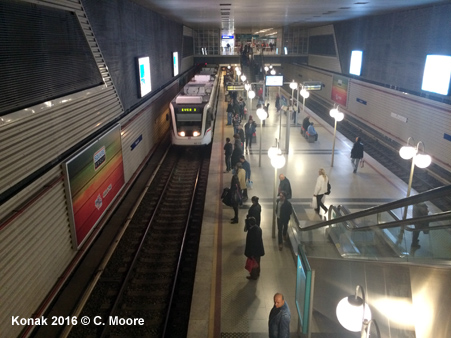
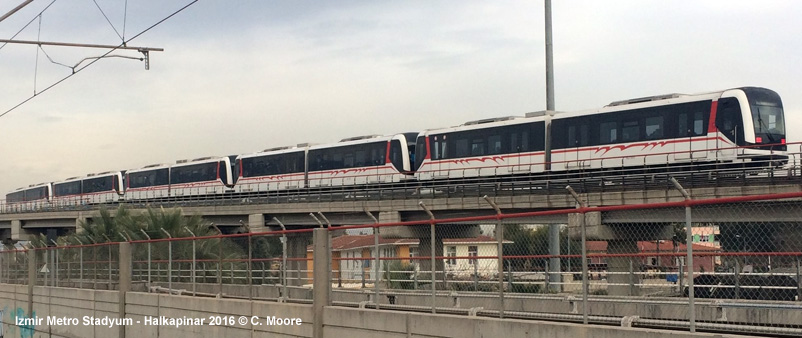 |
||
|
Projects |
||
|
Halkapinar
- Otogar (4.5 km) Buca metro line: driverless 12.5 km line starting at Üçyol station in a loop, passing through Zafertepe, Bozyaka, General Asim Gündüz, Sirinyer, Buca Belediyesi, Kasaplar Meydani, Hasanaga Bahçesi, Kredi Yurtlar Kurumu, Buca Koop and terminating at Çamlikule.
|
||
|
|
||
| TRAM | ||
|
- Tram Karsiyaka-Cigli -
opened 11 April 2017 (with free service until June 2017); running along
the north shore of the Gulf of Izmir (8.8 km); rolling stock: 17 five-section
low-floor trams supplied Eurotem (Hyundai Rotem + Tüvasas) - Tram Konak (12.8 km) -
opened 24 March 2018 (with free service until end of April 2018); running
along the south shore of the Gulf of Izmir and through the city centre. |
||
|
||
| IZBAN | ||
|
- Existing suburban lines (Banliyö) have been upgraded to provide an efficient suburban service operated with new CAF rolling stock: 1)
Northern Line: Alsancak - Aliaga, 57 km, 3.3 km underground at Karsiyaka 2)
Southern Line: Alsancak - Cumaovasi, 23 km, 1.7 km underground at Buca-Sirinyer,
opened Aug. 2010, serving Menderes Airport |
||
|
Photos
|
||
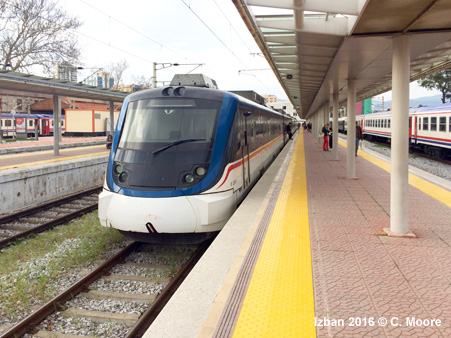
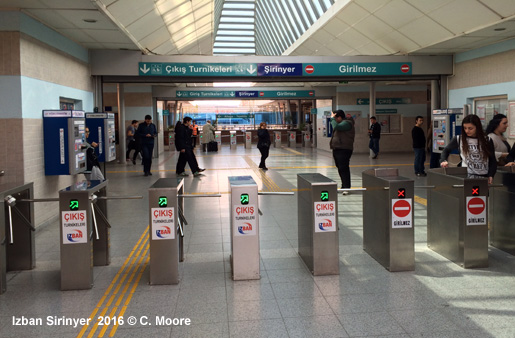
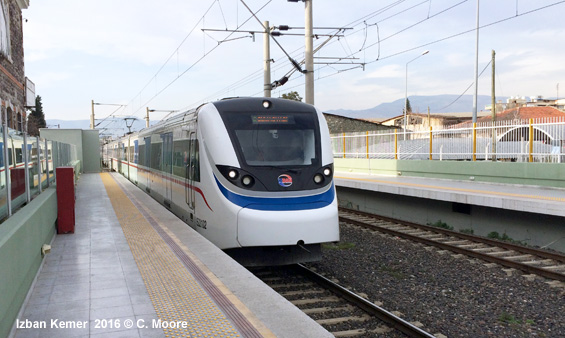
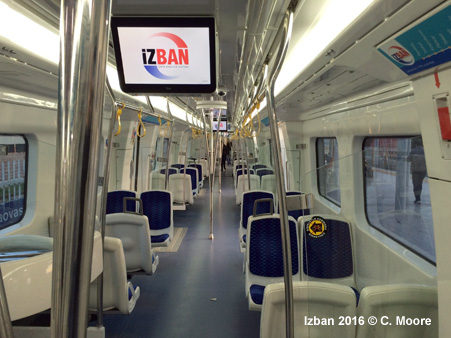
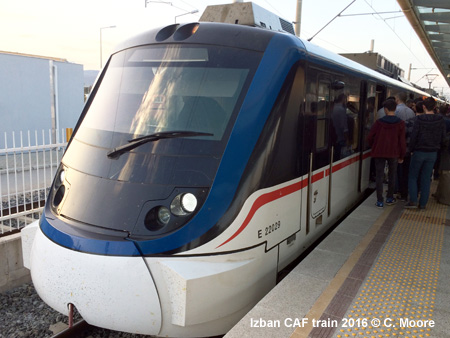
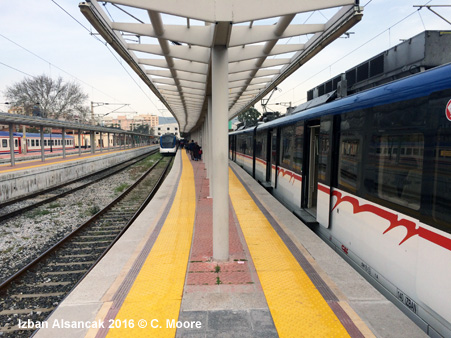
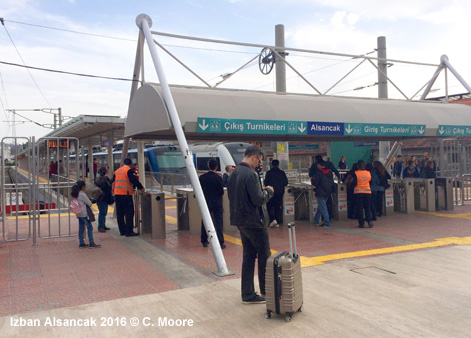
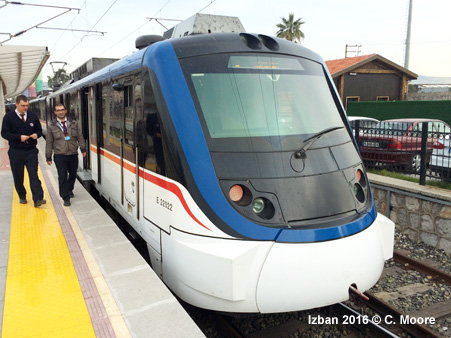
|
||
|
Links
|
||
|
Izmir Metro (Official Site) ESHOT - Izmir Transport Operator IZBAN (Egeray) - Suburban Rail Tram Izmir (Official Site) Izmir Metro at Wikipedia.de Ray Haber (Turkish Rail News)
|
||
|
Izmir
Impressions
|
||
|
In March 2016, Craig Moore reports from Izmir: Izmir has a very interesting Metro/Suburban Rail offer. The single line Metro runs across the main urban area, whilst the Izban suburban service runs from the north-west satellite towns, around the harbour, to the airport area in the south. Together the two services offer 73.1km of rail service, of which 15.5km is underground. There are 46 stations, of which 15 are underground. Opened in 2000, the 20.1km Izmir Metro line offers important transport provision through the centre of Izmir. From the south-western suburbs, the line runs north-east toward the city centre. This section is underground with Konak being the main station for the charismatic old town, and Cankaya and Basmane providing access to the stylish business and commercial centre of Izmir. The line rises to the interesting elevated station at Hilal which provides interchange to the Izban, before dropping to grade at the main Izban interchange of Halkapinar. Moving east, there is elevation at Stadyum, where the Metro Sheds are located, followed by grade running, before the line moves underground after Bornova. The journey time is 38mins. Underground stations in peripheral areas are located at major junctions and are easily located due to the Cube-topped pole and accessed by stairs. The entrance halls are very spacious and have automated ticket machines, a ticket office and crude timetable information. There are no schematic or geographic maps but small newsletters are offered at every station which provides a small schematic map in hard copy. The central underground stations have similar interiors, although the station facilities above ground are more substantial to oversee larger passenger numbers. The platforms are accessed by escalator and have side platforms in the periphery, and island platforms in the centre. There is a simple schematic of the single line with the current station highlighted. Hilal (side) and Halkapinar (island) are very large structures. Being elevated, Hilal is dominant in the landscape with lengthy passageways for physical integration with the Izban, whilst Halkapinar is parallel to the Izban station, separated by a fence. The grade stations to the east tend to have island platforms and have equally basic provision. Trains operate base headways of 4mins and are six-car sets (3x2), although the carriages are not particularly long and there is limited seating, which is paired rather than side seating. As for the stock, the newer CSR trains have a smart white interior, with RTI television screen route map and audio information in Turkish and English. There is also a small copy of the network schematic in each carriage. The older ABB stock looks quite dated in comparison. Both stock have smart exteriors of white, black with thin red stripe. The ride is not particularly smooth and dwell time can be quite lengthy but acceleration is good and patronage rates are very high, with Izban interchange stations being very busy. Izban is a suburban rail service operating from the north-west of the urban area, around the bay and through the central area before heading south to the airport and beyond. The Izban service was initiated in 2010 following a refurbishment of existing TCCD lines. Although maps and branding information declares that there are two lines operating to/from the central terminus of Alsancak, operationally this is one line, with trains working the Menemen-Cumaovasi service at 10min base headways. This route of 53km covers the more densely populated area of Greater Izmir and has 29 stations. The line has 1.9km of underground line on the northern section around Karsiyaka, and a short 0.5km in the south at Sirinyer. The line has 4 underground stations. Trains heading north enter Alsancak terminus station and drivers operate a step back service with the drivers of the last train waiting at the front of the next service, and so the dwell time is a matter of 30 seconds. Many people stay on the train and it is clearly perceived as one line, with strip map, audio and electronic information and destination displays all offering the single line identity. Service to the extended sections (Tepeköy in the south/Aliaga in the north) operate as cross-platform interchanges and utilise 3-car sets. These run at 15 and 30min headways to Aliaga and Tepeköy respectively. The core route passes through densely populated areas on the north of the Gulf of Izmir and the trains are busy all along the route. Around Turan the line runs along the bay and there is a good vista of the city to the south-east. From Salhane to Alsancak and on to Kemer the train travels very slowly, and because the trains have to cross junctions before Alsancak to arrive at the appropriate platform for the departing direction there is often conflict here and delay/disruption. This means that trains leaving the city centre are often not at the regular 10min headway. At Halkapinar the Izban line provides great views of the metro station and its rise to the elevated stations at either side. Moving south, the line offers great views of the citadel after Kemer and, after the short underground section speeds due south through the suburban heartland before reaching the airport and the terminus. The grade stations are similar with small entrance halls and turnstiles, Izban cubed totem and long, quite shallow platforms. These have basic timetable information and occasional seating as well as RTI next train indicators. The airport station is very substantial and quite different from the others, whist the few underground stations are quite large structures, have dull tiles and are quite dim. There are two stock types in use with the more frequently used older CAF stock, and the newer Hyundai Rotem trains. Both types use 9-car sets (3x3) on the 1435 mm rails, and are powered by overhead supply. The stock is smart with a similar exterior scheme to the Metro with the exception of a blue frontage. The interior has a mix of side and paired seating, above-door strip map, TV RTI route indicator and audio notices in Turkish and English. The trains accelerate well and are very swift outside of the congested central junctions, however, alighting trains is quite slow. At stations the doors are opened by button only and take some time as a step emerges to cover the significant gap between train and platform edge. As an aside, Hilal station has staggered platforms with the northbound platform after the line goes under the metro line above. The south line is south of the metro line. This means the physical interchange is quite lengthy. At Halkapinar the interchange is less labourious as the stations are located parallel to each other. Directional signage is very clear and it is easy. Both interchanges involve overhead walkways, offering great views of the overall rail infrastructure in that central junction area. On both counts, however, interchange involves exiting the metro or Izban system and purchasing a new ticket. Given the joint mappage and similar branding, it is disappointing that the two systems are not fully integrated. In terms of ticketing, the flat fare is 2.40TL (0.75) although a 6.00TL IzmirCard is required with which you add additional credit. No single tickets are sold |
||
Photos and info thanks to Serkan Avci!
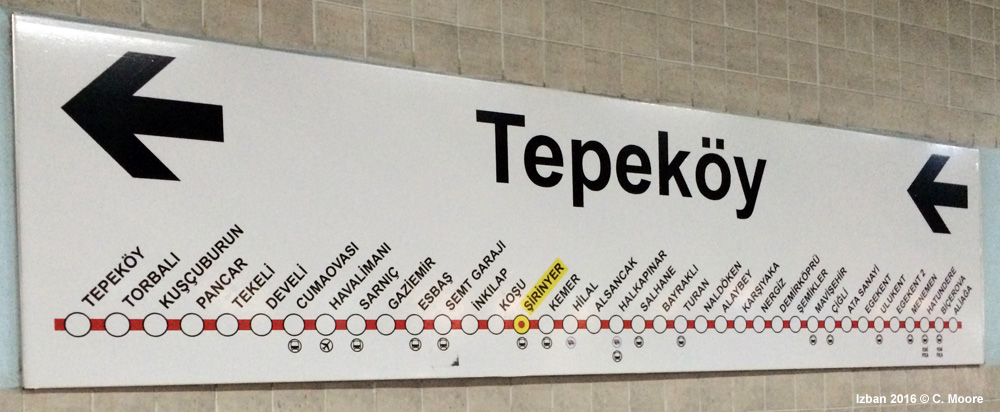
2007 © Robert Schwandl (UrbanRail.Net)